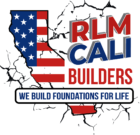Five foundation types
Basement
A complete basement foundation starts with a hole at least eight feet deep to allow a subterranean living area equal to the home’s ground level. Concrete footings will support structural basement walls. Footings must be 12 inches below the frost line and in undisturbed soil. Then you’ll add beams, foundation walls, and a cement slab.
If finished, a basement can double a home’s square footage. Long-lasting, fire- and weather-resistant basement foundations.
Because the home’s foundation must be below the frost line, they’re frequent in cold places like the Midwest, Mid-Atlantic, and Northeast. They’re heated and cooled like the rest of the house.
A basement is the most expensive foundation type, and its area may feel cave-like due to the absence of natural light unless you construct a daylight basement—one built on a slope with at least one side open to the sun. Flood-prone areas shouldn’t have basements. Even if your neighborhood doesn’t flood often, install a sump pump.
The daylight basement, with at least one side sunk from floor to ceiling and a separate entry, might be a terrific option for sloped-lot homes.
Stem-wall crawlspace
Stem walls form the foundations of crawlspace constructions. They build a raised space under a home where you may crawl, with room for storage, a furnace, and other equipment.
Crawlspaces protect homes. Raising the house’s foundation protects its walls from flooding and other hazards. This region has conveniently accessible plumbing, wiring, and other mechanical systems. Raising a house’s foundation makes it more lovely. It’s cheaper than digging a basement.
Warmer areas like California, Texas, the Northwest, and the South have these foundations. They’re also popular in earthquake-prone areas.
Elevated crawlspace foundations are resistant to termites, but moisture can cause mold and mildew. Crawlspace foundations are less expensive than basement foundations, but they still require maintenance: homeowners must check for leaks around plumbing components and install vapor barriers to keep the space dry.
Concrete slabs
A slab foundation is a single-piece, ground-level concrete slab. Monolithic foundations are cheaper and faster to create.
Installing is easy. Wire mesh and steel reinforcing bars are buried in a 2-foot-deep concrete beam around the slab’s perimeter. Slab-built homes don’t have crawlspaces, so homeowners don’t have to worry about maintenance.
No weak spots in a property’s poured concrete slab may disintegrate over time and produce foundation repair issues. In cold climates, they’re rare. As the soil freezes and thaws, concrete may crack and move.
Sewer and drainage pipes must be built before the concrete is poured. In case of sewage or plumbing problems, you must cut into the slab.
Solid wood
Wood foundations were popular in the 1960s. Builders use decay-resistant, easy-to-install preservative-treated timber. Wood foundations are faster and less expensive to create than concrete or brick.
Insulating these foundations create a warmer crawlspace and less drafty dwelling. Archaeologists have found Cyprus wood beams in 6000-year-old Egyptian pyramids.
Because cypress, redwood, and cedar are expensive and resistant to insects and mildew, the timber industry has devised procedures to treat other lumber to achieve similar effects. They don’t last as long as concrete and only work in dry soil.
Foundation Piers
A pier and beam foundation (sometimes called “piers and piling” or “pier and post”) is the best alternative for coastal situations with constantly changing, flooding, or eroding soil. They’re common in hurricane-prone or flood-prone areas. They must support and dry the house, thus they must be well-planned.
They anchor massive pillars—often over 15 yards long to reach firm ground—in the lowest stone and soil strata, like an ocean pier. Builders use them in heavier homes to spread the structure’s weight and prevent sinking.
A structural engineer must undertake a soil assessment to guarantee the building is built correctly. Driving concrete piers requires heavy machinery, so budget extra time and money.
Book a free Foundation Inspection Near Me Hermosa Beach with RLM Retrofit Foundation to understand how to extend your home’s life.
Concrete Structures Can Be Repaired If You Follow These Repair Tips Hermosa Beach
How to Keep an Eye on Fractured Foundations Hermosa Beach










